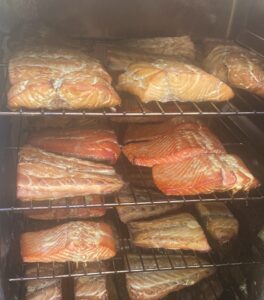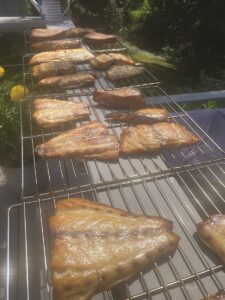A lot of people who go into Hatch’s Fish or Mac’s Seafood markets are shocked to discover that the smoked versions of their favorite seafood are $7 to $10 higher in price per pound than fresh filets.
How can that be, especially considering that it’s day-old fish that is turning such a nice profit for our favorite fish sellers?
As a longtime amateur smokehouse cook, I can attest that this seemingly egregious assault on your pocketbook is justified. Any fisherman like me who cleans and smokes his or her own catch knows how the hours from beach or boat to table add up.

Smoking is not just a matter of sticking food in a smoker and then serving it, tasty and golden brown, to your friends and family. Procuring aside, the fish I smoke — salmon, steelhead trout (these are not local but can sometimes be found on sale at the big “wholesale” clubs), bluefish, tuna, bonito, striper, and mackerel — take a minimum of two days to prepare.
My filets are brined for at least 12 hours (best in the fridge). Then they’re set out to dry on racks for up to 24 hours, depending on the weather. The smoking itself takes three hours or more and requires constant monitoring of the temperature.
I started smoking fish when I came to live in Wellfleet in the 1970s. Back then, bluefish were more plentiful than dollars in my pocket. I was working for the Provincetown Advocate, and the good winter life for a cub reporter and his family revolved around how many Wellfleet treasures we could stuff into our freezer.
Smoking meant treats for visitors, too. In those penniless days, the ground rules were that we supplied the oysters, clams, and fish, and they supplied all the things we couldn’t afford, like wine, beer, cheese, and steaks.

Hatch’s Fish Market was the first to smoke fish commercially in modern-era Wellfleet. When the market’s smoked-fish source went out of business in 1983, Rob McClellan, who had just purchased the business from its original owner, Cliff Hatch, decided to buy a modest-size smoker and do it himself.
(Full disclosure: Hatch’s runs in my family. Rob McClellan is my former brother-in-law, and current owners Katie and Adrian Kmiec are my niece and nephew-in-law.)
Rob tested various recipes and soon found he had to upgrade to a much larger smoker to fulfill the town’s voracious appetite for his smoked seafood.
Good smoked fish is a Cape Cod art form. As Rob and Adrian will confirm, every batch is unique. And while their recipes and preparation are among the town’s closest-held secrets, I am willing to share mine.
My brine consists of equal parts brown sugar and kosher salt, spiked with either port wine or maple syrup. The more port or syrup you add, the more their flavors will be noticed. I like equal parts sugar, salt, and port or syrup.
It is fine to freeze fish before smoking, and with oilier species like bluefish I prefer to freeze the fish before brining. The freezing breaks up the cellular structure of the flesh and allows the brine and smoke to penetrate more deeply and quickly.

It helps to have a smoker. While smoking on a good grill can work well for large cuts of meat and fowl, working with delicate fish requires more precision. A decent amateur-level smoker can be purchased for under $200. I use an electric Masterbuilt four-rack smoker with an electronic thermostat that allows me better control of both temperature and smoking time.
The crucial part of smoking is keeping the temperature as low as possible. If you let the smoker get up over 200° F, the fish will be cooked rather than smoked. It will lose its moisture well before it is properly saturated with smoke.
I highly recommend using a vacuum sealer for packaging the finished product. You can use plastic wrap, but it doesn’t fully protect the fish from freezer burn. Vacuum-bagged smoked fish will last indefinitely in the freezer and can be stored for weeks in the refrigerator without significant loss of quality.
The time and effort of home smoking is worthwhile in so many ways. Besides oysters, nothing is a more quintessential Wellfleet offering than a slab of smoked bluefish. It’s the toast of just about every party in town. If you don’t believe that, step inside Mac’s or Hatch’s and watch how fast the smoked fish walks out the door.
Jim Gilbert’s Smoked Fish
Makes about 5 lbs.
8 to 10 lbs. bluefish or other fresh fish filets — striped bass, tuna or bonito, mackerel, salmon, steelhead or other trout
2 gallons cold water
1 cup brown sugar
1 cup kosher salt
1 cup tawny port wine or maple syrup
A bag of smoking chips — apple, cherry, mesquite, or other suitable hardwood; types can be mixed
- Place water, brown sugar, salt, and either port or maple syrup in a large pot. Stir until brine is clear.
- Cut filets into 6- to 8-oz. pieces. Smoking will reduce the size of each piece by 50 percent or more. It’s OK to place frozen filets directly in brine to thaw. Those filets can be cut into desired sizes after brining.
- Refrigerate fish and brine for about 12 hours. The longer the fish remains in brine the saltier the finished product will be.
- Remove fish from brine and dry both sides of each piece with paper towels before placing skin side down on smoker trays, racks, or other ventilated drying surfaces. (I use an old screen door placed between crates in the basement.)
Drying can also be done in the refrigerator. If you dry fish in the refrigerator, be sure to bring it to room temperature before smoking. Cold fish will release smoke-reducing moisture and even discolor the fish.
Drying time will vary with ambient temperature and humidity and can take as long as 24 hours. Dry it until a slightly tacky glaze appears on the top side of fish. If I’m working on a sunny day, I like to bring my fish into the sun for an hour before placing it in the smoker — I use a strong fan to keep the flies away.
- Make sure smoker is clean before firing it up. Chips should begin smoldering in 10 minutes. Set the smoker at 190° F. On warm days, it’s OK to splash the chips with water to help keep the smoker cooler. If the humidity is above 60 percent, do not fill the smoker’s water tray.
- Transfer fish pieces from drying trays to smoker trays that have been sprayed with olive oil or other cooking oil. Arrange pieces with sufficient space between them to allow smoke to surround the meat. Give each piece a gentle nudge to make sure it is not sticking to the tray’s surface.
- Place racks in preheated smoker. Check the smoker periodically to make sure the temperature is steady and chips are smoking. If one rack seems to be smoking faster than others (it will look darker), switch the racks around.
I check every 15 minutes in warmer, more humid months, every 20 minutes in cooler months. Replace chips as necessary. If smoker gets too warm (more than 20 degrees above 190° F), open vents or the door to restore smoker to desired temperature.
- After an hour, check the fish by gently pressing the flesh of a thicker filet. The softer the flesh the more moisture remains. Too soft and the fish will be soggy. Too firm and the fish will be overcooked. When the fish is golden brown and is slightly soft and springy to the touch it is ready. With my smoker at 190° F, smoking takes between 2¼ and 3 hours.
- Remove trays and allow fish to cool for 45 minutes. Gently slide a thin spatula beneath the pieces to loosen from the rack. Don’t worry if piece of the skin sticks; when this happens gently separate fish from skin.
- When smoked filets are cool, wrap them in plastic wrap or seal in vacuum bags. Vacuum-bagging is not necessary but prevents freezer burn better than plastic wrap. And it lends a professional look to the pieces you hand out to friends and family as gifts (or bribes).
